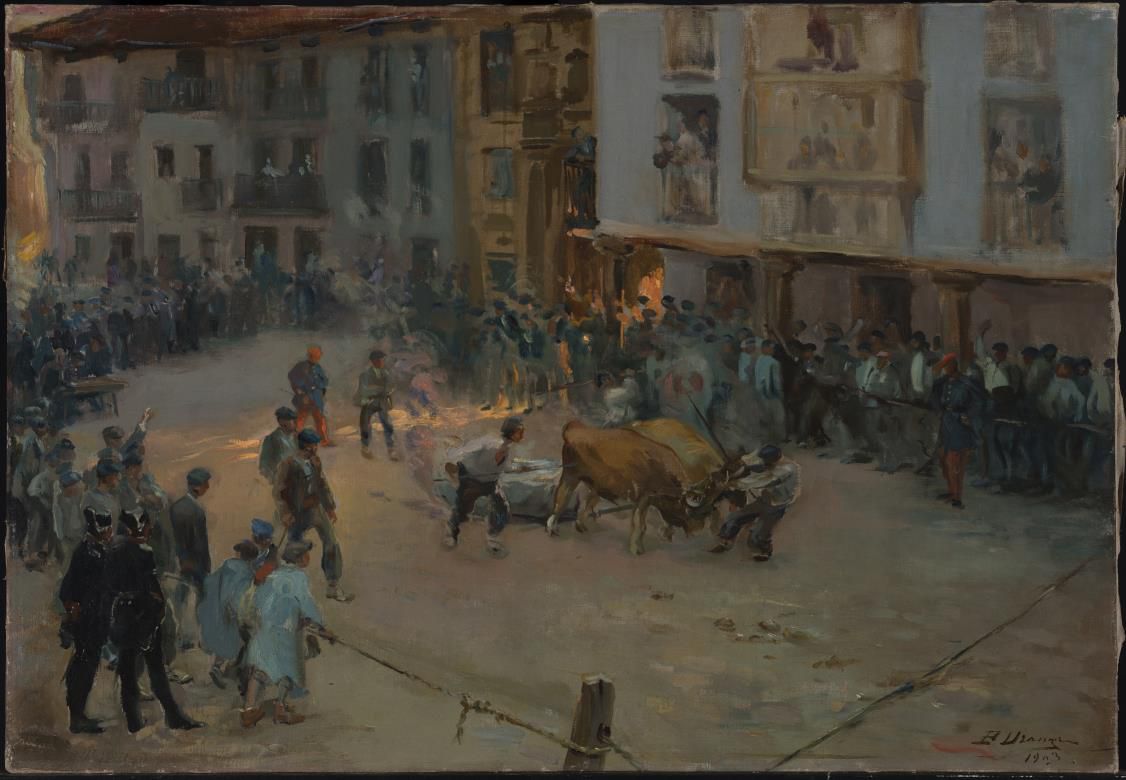The online collection and picture sale

Oxen Dragging Stone in Elgeta
Uranga, Pablo
Vitoria-Gasteiz, 26/06/1861-San Sebastián, 06/11/1934
Oil on canvas
66.5 x 96 cm
P Uranga (bottom right hand corner)
1903
First decade of the 20th century
82/98
Contributed by the Provincial Council of Bizkaia in 1913
Born into a Catholic family of traditional values, Uranga was orphaned at a very early age. From 1878 to 1880 he trained at the School of Arts & Crafts in Vitoria, under Emilio Soubrier. After later studying at the School of Fine Arts in Jerez de la Frontera (Cadiz), he moved to Madrid, where he continued his training at the San Fernando Royal Academy of Fine Arts. There he became close friends with sculptor Francisco Durrio and frequented the Prado, where he made copies of the great masters and became captivated by the works of El Greco.
His time in Paris, in the 1890s, was marked at first by economic problems, when he produced paintings on popular themes, bullfighting and landscapes. He became friends with Rusiñol and Jordá and in particular with Zuloaga and Durrio. From 1893 he was a member of the Société des Artistes Indépendants and in 1897 he held a one-man show at Le Barc de Boutteville. After his return to Spain, in early 1903, he married and moved to Elgeta, in the province of Gipuzkoa, where he concentrated once again on popular themes, as he did in this Oxen Dragging a Stone in Elgeta. Here, the artist applies his characteristically sober tone, vibrantly rendered to match the movement of the activity portrayed: a typical Basque scene, a mixture of rural sport and betting. Another important feature is the way he modulates the effects of the light, with the sun's glare erupting in one of the streets transversal to the plaza and the suave contrasts of the shadows, all developed within a studied compositional frame.
In 1906 Uranga moved to Vitoria, where he remained until 1918. This was a period of great creative activity, combined with his work in Bilbao in the AAV (Association of Basque Artists). In 1924, he went with Zuloaga to the United States, where he exhibited in Palm Beach. Uranga's extraordinary creative range (he worked a rich variety of themes, producing large-scale paintings and murals), his way of painting, on occasions fast and spontaneous, and a life spent in the permanent shadow of his inseparable friend Ignacio Zuloaga, has led to his output being judged, erroneously, as uneven and lacking a distinct, individual style. [Javier Novo González]
Selected bibliography
- Flores Kaperotxipi, Mauricio. Vida, obra y anécdotas del pintor Pablo Uranga. San Sebastián, Auñamendi, 1963. pp. 36, 100, il.
- "Cuales fueron los dieciseis cuadros enviados por los rojos al Extranjero, otros trece han sido encontrados en el Carlton", Hierro. 28 de septiembre de 1937. p. 3.
- Mur Pastor, Pilar. La Asociación de Artistas Vascos. Bilbao, Museo de Bellas Artes de Bilbao ; Caja de Ahoros Vizcaína, 1985. p. 37, il.
- Pablo Uranga, 1861-1934 [Cat. exp.]. San Sebastián, Sociedad Guipuzcoana de Ediciones y Publicaciones, Obra Cultural de Kutxa-Caja Gipuzkoa, 1992. p. 227. N° cat. 34
- Pablo Uranga, 1861-1934 [Cat. exp.]. Vitoria-Gasteiz, Diputación Foral de Álava, Museo de Bellas Artes de Alava, 1992. p. 227. N° cat. 34
- 5 pintores vascos en Segovia [Cat. exp.]. Segovia, Caja Segovia, 1993. p. 48.
- Encina, Juan de la. La trama del arte vasco. Bilbao, Museo de Bellas Artes de Bilbao, 1998. s. p.
- González de Durana, Javier. Las Exposiciones de Arte Moderno de Bilbao, 1900-1910 : un intento modernizador pagado con espinas de indiferencia. Vitoria-Gasteiz, Bassarai, 2007. p. 146.
- Guía Artistas Vascos. Bilbao, Museo de Bellas Artes de Bilbao, 2008. p. 44.
- Gida Euskal Artistak. Bilbao, Bilboko Arte Eder Museoa, 2008. p. 44.
- Guide Basque Artists. Bilbao, Bilbao Fine Arts Museum, 2012. p. 44, n° cat. 19.
- Pablo Uranga : Elgetako bohemioa = el bohemio de Elgeta [Cat. exp.]. Vitoria-Gasteiz, Diputación Foral de Alava, 2012.
